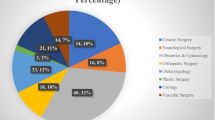Abstract
Background
In accordance with the American Academy of Orthopaedic Surgeons’ strategic goal of enriching our field by building a more diverse orthopaedic workforce, the specialty needs further information delineating the factors important to the applicant pool as a whole and more specifically to women and other underrepresented minority groups.
Questions/purposes
This study aims to identify (1) factors important to residency applicants selecting an orthopaedic residency program; (2) differences in factor importance for men, women, and minorities, and (3) the importance of different information sources used when making his or her rank list.
Methods
All 742 applicants who applied to the authors’ orthopaedic surgery residency program in the 2013 National Resident Matching Program were queried. The response rate was 28% (207 of 742). Respondents were asked to rank, on a 5-point Likert scale, 37 factors that may have affected their rank lists to differing degrees. Respondents also identified the importance of sources of information used to make their rank lists, factors that residency programs considered important when ranking applicants, and their level of agreement with various sex- and racial-specific statements regarding orthopaedic training.
Results
The most important factors affecting rank lists were perceived happiness/quality of life of current residents, resident camaraderie, and impression after an away rotation. Women weighed their personal interactions and a program’s proximity to family and friends more heavily when determining a rank list. Sixty-eight percent of women eliminated residency programs from their options based on perceived sex biases versus less than 1% of men. Applicants valued information obtained from away rotations at an institution and in talking with current residents most when determining his or her rank list.
Conclusions
Programs should consider interpersonal factors, like quality of life and resident camaraderie as factors in attracting applicants. They also should minimize perceived biases and emphasize interactions with current residents during the application process to meet their goals of attracting an exceptional and more diverse orthopaedic workforce.
Similar content being viewed by others
References
American Academy of Orthopaedic Surgeons. Diversity in Orthopaedics. Available at: http://www3.aaos.org/About/diversity/index.cfm. Accessed April 26, 2013.
Bernstein AD, Jazrawi LM, Elbeshbeshy B, Della Valle CJ, Zuckerman JD. Orthopaedic resident-selection criteria. J Bone Joint Surg Am. 2002;84:2090–2096.
Bernstein AD, Jazrawi LM, Elbeshbeshy B, Della Valle CJ, Zuckerman JD. An analysis of orthopaedic residency selection criteria. Bull Hosp Jt Dis. 2002–2003;61:49–57.
Department of Research and Scientific Affairs, American Academy of Orthopaedic Surgeons. 1998–2011 Resident Diversity Survey Report. March 9, 2012. Available at: http://www3.aaos.org/about/diversity/pdfs/resident_trend.pdf. Accessed April 26, 2013.
DeSantis M, Marco CA. Emergency medicine residency selection: factors influencing candidate decisions. Acad Emerg Med. 2005;12:559–561.
Egol KA, Collins J, Zuckerman JD. Success in orthopaedic training: resident selection and predictors of quality performance. J Am Acad Orthop Surg. 2011;19:72–80.
Evarts CM. Resident selection: a key to the future of orthopaedics. Clin Orthop Relat Res. 2006;449:39–43.
Flynn TC, Gerrity MS, Berkowitz LR. What do applicants look for when selecting internal medicine residency programs? A comparison of rating scale and open-ended responses. J Gen Intern Med. 1993;8:249–254.
Lewis VO, Scherl SA, O’Connor MI. Women in orthopaedics: way behind the numbers curve. J Bone Joint Surg Am. 2012;94:e30.
Pretorius ES, Hrung J. Factors that affect National Resident Matching Program rankings of medical students applying for radiology residency. Acad Radiol. 2002;9:75–81.
Proucznik MA. Where are the women orthopaedists? AAOS Now. 2008;2. Available at: http://www.aaos.org/news/aaosnow/feb08/cover2.asp. Accessed May 1, 2014.
Sanfilippo JA, Sharkey PF, Parvizi J. Criteria used by medical students to rank orthopaedic surgery residency programs. Am J Orthop (Belle Mead NJ). 2006;35:512–514.
Spitzer AB, Gage MJ, Looze CA, Walsh M, Zuckerman JD, Egol KA. Factors associated with successful performance in an orthopaedic surgery residency. J Bone Joint Surg Am. 2009;91:2750–2755.
Stefanidis D, Miles WS, Greene FL. Factors influencing residency choice of general surgery applicants: how important is the availability of a skills curriculum? J Surg Educ. 2009;66:325–329.
The Match National Residency Matching Program: Results and data: 2013 main residency match. Available at: http://www.nrmp.org/wp-content/uploads/2013/08/resultsanddata2013.pdf. Accessed July 9, 2013.
Yarris MS, Delorio NM, Lowe RA. Factors applicants value when selecting an emergency medicine residency. West J Emerg Med. 2009;10:159–162.
Acknowledgments
We thank Rachel Seymour PhD for contributions to the statistical analyses in this study.
Author information
Authors and Affiliations
Corresponding author
Additional information
Each author certifies that he or she, or a member of his or her immediate family, has no funding or commercial associations (eg, consultancies, stock ownership, equity interest, patent/licensing arrangements, etc) that might pose a conflict of interest in connection with the submitted article.
All ICMJE Conflict of Interest Forms for authors and Clinical Orthopaedics and Related Research editors and board members are on file with the publication and can be viewed on request.
Each author certifies that his or her institution approved the human protocol for this investigation, that all investigations were conducted in conformity with ethical principles of research, and that informed consent for participation in the study was obtained.
About this article
Cite this article
Huntington, W.P., Haines, N. & Patt, J.C. What Factors Influence Applicants’ Rankings of Orthopaedic Surgery Residency Programs in the National Resident Matching Program?. Clin Orthop Relat Res 472, 2859–2866 (2014). https://doi.org/10.1007/s11999-014-3692-9
Received:
Accepted:
Published:
Issue Date:
DOI: https://doi.org/10.1007/s11999-014-3692-9




